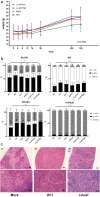Preclinical Optimization and Safety Studies of a New Lentiviral Gene Therapy for p47phox-Deficient Chronic Granulomatous Disease
- PMID: 33740872
- PMCID: PMC8575060
- DOI: 10.1089/hum.2020.276
Preclinical Optimization and Safety Studies of a New Lentiviral Gene Therapy for p47phox-Deficient Chronic Granulomatous Disease
Abstract
Chronic granulomatous disease (CGD) is an inherited blood disorder of phagocytic cells that renders patients susceptible to infections and inflammation. A recent clinical trial of lentiviral gene therapy for the most frequent form of CGD, X-linked, has demonstrated stable correction over time, with no adverse events related to the gene therapy procedure. We have recently developed a parallel lentiviral vector for p47phox-deficient CGD (p47phoxCGD), the second most common form of this disease. Using this vector, we have observed biochemical correction of CGD in a mouse model of the disease. In preparation for clinical trial approval, we have performed standardized preclinical studies following Good Laboratory Practice (GLP) principles, to assess the safety of the gene therapy procedure. We report no evidence of adverse events, including mutagenesis and tumorigenesis, in human hematopoietic stem cells transduced with the lentiviral vector. Biodistribution studies of transduced human CD34+ cells indicate that the homing properties or engraftment ability of the stem cells is not negatively affected. CD34+ cells derived from a p47phoxCGD patient were subjected to an optimized transduction protocol and transplanted into immunocompromised mice. After the procedure, patient-derived neutrophils resumed their function, suggesting that gene correction was successful. These studies pave the way to a first-in-man clinical trial of lentiviral gene therapy for the treatment of p47phoxCGD.
Keywords: biodistribution; chronic granulomatous disease; genotoxicity; lentiviral gene therapy.
Conflict of interest statement
The authors declare no conflict of interest. A.J.T. is on the Scientific Advisory Board of Orchard Therapeutics and Rocket Pharmaceuticals. H.L.M. is on the Scientific Advisory Board of Orchard Therapeutics and on the Safety Monitoring Board of Rocket Pharmaceuticals. H.B.G. is Chief Executive Officer for Orchard Therapeutics.
Figures




Similar articles
-
Lentiviral gene therapy rescues p47phox chronic granulomatous disease and the ability to fight Salmonella infection in mice.Gene Ther. 2020 Sep;27(9):459-469. doi: 10.1038/s41434-020-0164-6. Epub 2020 Jun 12. Gene Ther. 2020. PMID: 32533104 Free PMC article.
-
Non-Clinical Efficacy and Safety Studies on G1XCGD, a Lentiviral Vector for Ex Vivo Gene Therapy of X-Linked Chronic Granulomatous Disease.Hum Gene Ther Clin Dev. 2018 Jun;29(2):69-79. doi: 10.1089/humc.2017.245. Epub 2018 Apr 17. Hum Gene Ther Clin Dev. 2018. PMID: 29664709
-
Chronic Granulomatous Disease: a Comprehensive Review.Clin Rev Allergy Immunol. 2021 Oct;61(2):101-113. doi: 10.1007/s12016-020-08800-x. Clin Rev Allergy Immunol. 2021. PMID: 32524254 Review.
-
Third-generation, self-inactivating gp91(phox) lentivector corrects the oxidase defect in NOD/SCID mouse-repopulating peripheral blood-mobilized CD34+ cells from patients with X-linked chronic granulomatous disease.Blood. 2002 Dec 15;100(13):4381-90. doi: 10.1182/blood-2001-12-0165. Epub 2002 Aug 1. Blood. 2002. PMID: 12393624
-
Chronic granulomatous disease: Clinical, molecular, and therapeutic aspects.Pediatr Allergy Immunol. 2016 May;27(3):242-53. doi: 10.1111/pai.12527. Epub 2016 Jan 21. Pediatr Allergy Immunol. 2016. PMID: 26680691 Review.
Cited by
-
Design and validation of a GMP stem cell manufacturing protocol for MPSII hematopoietic stem cell gene therapy.Mol Ther Methods Clin Dev. 2024 May 21;32(2):101271. doi: 10.1016/j.omtm.2024.101271. eCollection 2024 Jun 13. Mol Ther Methods Clin Dev. 2024. PMID: 38946936 Free PMC article.
References
-
- Koker MY, Camcioglu Y, van Leeuwen K, et al. . Clinical, functional, and genetic characterization of chronic granulomatous disease in 89 Turkish patients. J Allergy Clin Immunol 2013;132:1156–1163.e5. - PubMed
-
- Tajik S, Badalzadeh M, Fazlollahi MR, et al. . Genetic and molecular findings of 38 Iranian patients with chronic granulomatous disease caused by p47-phox defect. Scand J Immunol 2019;90:e12767. - PubMed
-
- Kutukculer N, Aykut A, Karaca NE, et al. . Chronic granulamatous disease: two decades of experience from a paediatric immunology unit in a country with high rate of consangineous marriages. Scand J Immunol 2019;89:e12737. - PubMed
Publication types
MeSH terms
Substances
Grants and funding
LinkOut - more resources
Full Text Sources
Other Literature Sources
